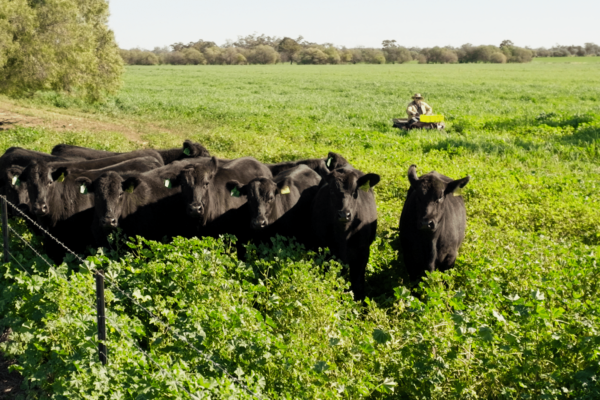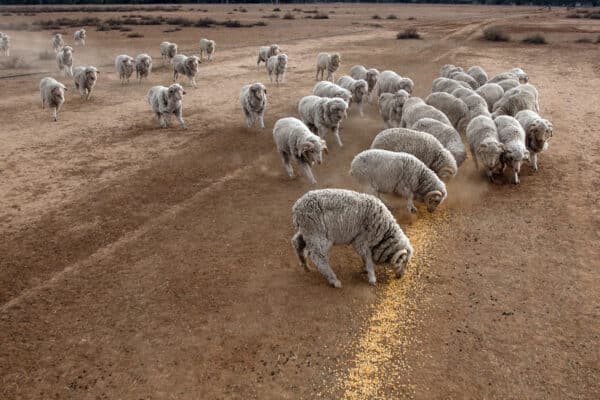There are two different types of sheep grain feeding occurring in Australia.
- Full sheep grain feeding, where lambs are locked in feed yards. 100% of the diet comes from the total mixed ration (TMR).
- Paddock Grain Assisting, where the lambs/sheep live in the paddock and are provided with access to grain feeders or trial fed. The percentage of their diet from the grain bin will depend on the paddock feed available. This percentage can range from as little as 1-2 % to 100% in severe drought conditions.
Both systems require induction. (Induction requires a week long process where sheep are slowly introduced to higher grain diets; to reduce the stress and weight loss of the animal in the first week from acidosis) Consequently, over the last 8 years, RumenWorks Nutrition has formulated many successful induction programs for both systems. However, how we induct the lambs to feed will depend entirely on the history of the sheep. For instance, if they have been imprinted to feed troughs, (ie ewe and lamb have had access to lick troughs prior to weaning) getting lambs inducted onto grain diets will be much easier than if they have not seen feeders before. Moreover, buying in-store lambs is difficult because you often don’t know their feeding history—one advantage of feeding your own lambs.
Please contact us at RumenWorks so we can develop a specific program to suit your particular sheep grain feeding needs.
Here are a few essential tips to consider when paddock feeding lambs
Before commencing a feeding program, it is vital to ensure a good animal health program is in place. This involves worm and fluke monitoring and drenching as test results dictate. In addition, ensure all vaccination programs are fully up to date. Plus, where possible, use a clostridial vaccine that includes vitamin B12.
Paddock Infrastructure
Before commencing sheep grain feeding, you must ensure enough feeders are in the paddock. Plus, ensure that they are distributed around the paddock for easy access; close to water initially is ideal. As a guide, we allow 40-50mm per lamb and 50-100mm of trough space per adult sheep. Allow an extra 20mm for sheep with full wool.
The use of self-feeders in the paddock is the most common form of grain-assisting lambs. Self-feeders remove the need to feed daily, creating a labour-efficient process. Furthermore, another advantage of self-feeders is they are more suited to finishing stock to a marketable weight – sheep can maximise feed intake.
Finally, to ensure quicker uptake, put lambs into a smaller paddock to be easily observed for the first week of feeding. In particular, watch for shy feeders; we want to see more than 90 per cent of lambs on feeders as quickly as possible.
Sheep Grain Feeding Ration Design
Always use whole, unprocessed grain. Whole oats can be used successfully as an induction grain. Grain should make up at least 50% of the ration for the first week. In addition, it’s important to ensure you have a pulse grain such as Lupins or a protein meal available at all times.
Always get your grains tested for protein and energy. This is a simple test that enables the nutritionists at RumenWorks to analyse the test results and make specific recommendations for you.
Also, it is essential to use an additive/buffer pellet explicitly designed for paddock feeding. This is because many products are designed for full feedlot feeding, which is very different from sheep grain feeding in the paddock. For example, RumenWorks Grain Assist pellet or RumenWorks Protein Plus Pellet has been designed with the correct mixture of rumen buffers, vitamins and minerals. They also contain the probiotic Saccharomyces Crevasse to maximise feed conversion.
Roughage can be provided in the paddock from hay feeders with quality cereal straw, which is very important when supplementing in pasture crops such as oats and brassicas.




